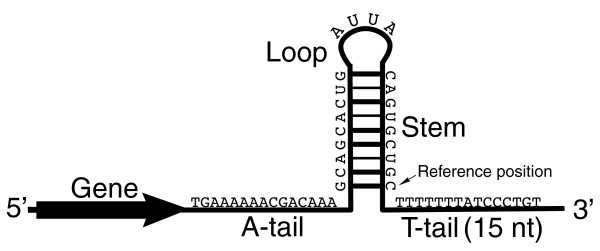|
|
| (11 intermediate revisions by one other user not shown) |
| Line 1: |
Line 1: |
| − | [[Image:Part icon terminator.png]] | + | [[Category:Terminators]] |
| − | <small> | + | [[Terminators|< Back to Terminators]] |
| − | Browse [https://parts.igem.org/cgi/partsdb/pgroup.cgi?pgroup=terminator terminator parts]!</small>
| + | |
| − | <hr>
| + | |
| | | | |
| − | A terminator (short for "transcriptional terminator") is a stretch of DNA which halts the otherwise continuous process of transcription (making the RNA copy of a DNA sequence).
| + | {{:Terminators/Overview}} |
| | | | |
| − | ==Assembly with terminators==
| + | *[[Help:Terminators/Mechanism|'''How''']] do terminators work? |
| − | The hairpin structure created by the terminator sequence and its small sequence size make it quite difficult to remove this piece from a plasmid. It is much easier to leave the piece inside of its plasmid and ligate another brick ahead of or behind this one.
| + | *[[Help:Terminators/Glossary|'''Glossary''']] of terms relating to terminators |
| − | | + | *[[Help:Terminators/Design|'''How to design a terminator''']] |
| − | ==Stem-loop type terminators==
| + | *[[Help:Terminators/Construction|'''How to construct an terminator''']] |
| − | [[Image:B0011 - stem loop terminator.png|thumb|An example of a stem-loop coding region (location indicated by the hairpin picture) in [[Part:BBa_B0011]]]] | + | *[[Help:Terminators/Measurement|'''How termination efficiencies are measured''']] |
| − | In our prokaryotic BioBrick [https://parts.igem.org/cgi/partsdb/pgroup.cgi?pgroup=cell host cells] these [https://parts.igem.org/cgi/partsdb/pgroup.cgi?pgroup=terminator terminator parts] are often palindromic (same sequence forwards and backwards on the two DNA strands) and the RNA transcript (the second half of which is the reverse complement of the first half) forms a stem-loop structure by folding back on itself. This structure then terminates transcription.<br>
| + | *[[Help:Terminators/Further reading|'''Further reading''']] about terminator sequence and function |
| − | One example of a BioBrick which uses this method is the terminator [[Part:BBa_B0011]], which has the sequence"<font color = "green">aaaagccagattat</font><font color = "red">taatccggctttt</font>" on one DNA strand. The corresponding RNA transcript (with U's in place of T's) can fold back into a hairpin with the green nucleotides running right-to-left and the red left-to-right. (Try drawing out the base-paired structure -- the middle of the hairpin has three unpaired bases and the stem has one mismatch.)
| + | *[[Terminators/Catalog|'''Browse''']] the terminator parts available from the registry |
| − | | + | |
| − | ==PolyA tails==
| + | |
| − | In eukaryotic hosts such as [https://parts.igem.org/wiki/index.php/Yeast yeast], the signals for termination follow the coding regions of the genes. These signals can occur as many as 1000 nucleotides downstream of the final, functional transcripts. For protein-coding genes this untranslated region (called a 3'-UTR) gets cut at a specific site and a string of adenine ("A") nucleotides is added that serves to protect the transcript. A number of sequence features help to specify this location. One frequent component of this set of signals is the "polyA" motif "<b>AAUAAA</b>".
| + | |
| − | | + | |
| − | ==Rho type terminators==
| + | |
| − | Another method which bacterial cells like ''E. coli'' use to terminate a sequence is through the action of the Rho protein.
| + | |
Latest revision as of 21:41, 20 July 2017
< Back to Terminators

A rho-independent transcriptional terminator. Image courtesy of
Kingsford et al..
Terminators are genetic parts that usually occur at the end of a gene or operon and cause transcription to stop. In prokaryotes, terminators usually fall into two categories (1) rho-independent terminators and (2) rho-dependent terminators.
Rho-independent terminators are generally composed of palindromic sequence that forms a stem loop rich in G-C base pairs followed by several T bases. The conventional model of transcriptional termination is that the stem loop causes RNA polymerase to pause and transcription of the poly-A tail causes the RNA:DNA duplex to unwind and dissociate from RNA polymerase.
All the E. coli terminators in the Registry are rho-independent terminators. Rho-dependent terminators are not included, because rho-dependent terminators are not specified by sequence.

